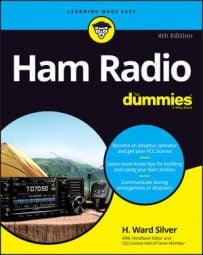You needn’t have a huge and powerful station to enjoy contesting; most contesters have a simple setup. Besides, the most important part is the operator. If you listen, know the rules, and have your station ready to go, you’re all set.
Making ham radio contest contacts
Here’s an example of a contact in a typical contest: the Washington State Salmon Run. (State contests are often referred to as QSO parties, to emphasize their easygoing style.) In this scenario, I’m W7VMI in King County, calling CQ to solicit contacts, and you’re W1AW in Connecticut, tuning around the band to find Washington stations. The information we exchange is a signal report and my county and your state, because (at least for this example) you’re not in Washington.Me (W7VMI): CQ Salmon Run CQ Salmon Run from Whiskey Seven Victor Mike India.
You (W1AW): Whiskey One Alfa Whiskey.
(Note: You send or say your call sign once, using standard phonetics on voice transmissions.)
W7VMI: W1AW, you’re five-nine in King County.
W1AW: QSL, W7VMI, you’re five-nine in Connecticut.
W7VMI: Thanks, QRZed Salmon Run Whiskey Seven Victor Mike India.
The whole thing takes about ten seconds. Each station identifies and exchanges the required information. “Five-nine” is the required signal report signifying “loud and clear.” That’s an efficient contest contact, and most contacts are similar.When the contact is over, keep tuning for another station calling “CQ contest.” This method of finding stations to call is searching and pouncing.
What if you miss something? Maybe you’ve just tuned in the station, and the band is noisy or the signal is weak. To continue the preceding example, response to your call might sound like this:
Me (W7VMI): W1AW, you’re five-nine in BZZZZTCRASH@#$%^&*.
You (W1AW): Sorry, please repeat your county.
W7VMI: Kilo India November Golf, King County.
W1AW: QSL, W7VMI, you’re five-nine in Connecticut.
You’re probably thinking, “But I missed the county. How can the signal report be five-nine?” By convention, most contesters say “Five-nine,” type 599, or send 5NN in Morse code (the N represents an abbreviated 9). Since the signal report doesn’t affect the score unless it’s miscopied, contesters have naturally decided not to make more work for themselves and send the same signal report.Contesting is no more complicated than getting your sandwich order taken at a busy deli counter during lunch hour. Contesting has a million variations, but you’ll quickly recognize the basic format.
If you’re unsure of yourself, try “singing along” without actually transmitting. Make a cue card that contains all the information you need to say or send. If you think you may get flustered when the other station answers your call, listen to a few contacts, and copy the information ahead of time. Serial numbers advance one at a time, so you can have all the information before your contact.
Your score for almost all contests is made up of QSO points and multipliers. Each contact counts for one or more QSO points, sometimes depending on the mode, band, or other special consideration. Multipliers — so named because they multiply QSO points for the final score — are what make each contest an exciting treasure hunt. Depending on the theme, you may be hunting for states, grids, counties, lighthouses, islands, or anything else. Read the rules carefully to find out how the multipliers are counted: only once, once per band, once per mode, and so on. Special bonus points may be awarded for working certain stations or multipliers.You don’t have to be a speed demon; just be steady. Good contest operators are smooth and efficient, so send your full call sign once. If the station answers with your call sign, log the exchange and send your information only once, even if you’re using a small station. The other operator will ask you to repeat yourself if he or she misses some of the information.
Logging your ham radio contacts
Manual logging (with pencil and paper) is the easiest method when you’re a beginner. Often, the contest sponsor has a log sheet that you can download or print from a website. After the contest, you can convert your written entry to electronic form by using logging software or an online converter such the one at b4h.net.If you’re a more experienced contester, using a general-purpose logging program or special contesting software makes contesting much easier. The software keeps score, maintains a dupe list (a list of stations you’ve already worked), shows needed multipliers, connects to spotting networks, and creates properly formatted logs to submit to the sponsors.
This table lists some popular software programs. Entering contest logger in a search engine also turns up many useful programs.
| Software | URL |
| CQ/X (for mobile operation in state QSO parties) | www.no5w.com |
| N1MM Logger+ | n1mm.hamdocs.com/tiki-index.php |
| WriteLog | www.writelog.com |
| N3FJP contest loggers | www.n3fjp.com |
| Rover Log | code.google.com/p/roverlog |
| Win-Test | www.win-test.com |
| SD by EI5DI | www.ei5di.com |
Many sponsors post a Logs Received web page that you can check to make sure that your log was received. Don’t miss the deadline — usually a few days after the contest — for submitting logs. Even if you’re not interested in having your score posted in the results, submitting your log just for the sponsor to use in checking other logs helps improve the quality of the final scoring.

